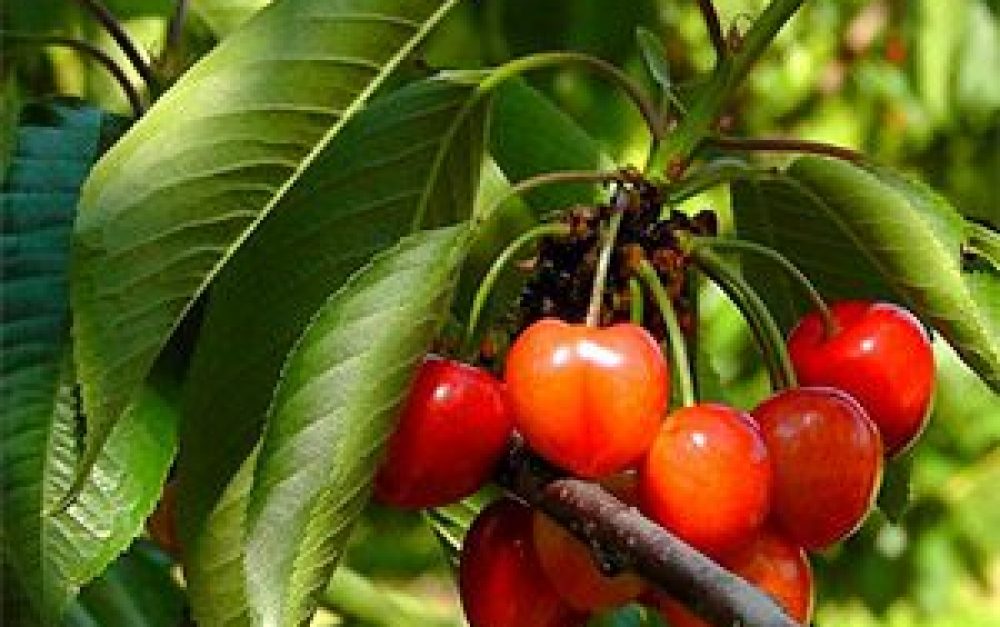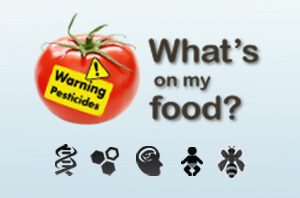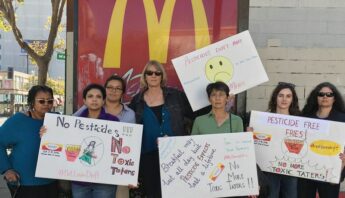Last week, I harvested the first cherries from our backyard tree. They were yummy, gorgeous and fresh — so satisfying! Having planted the little tree just last spring and tended it since, it was also satisfying to know the sweet fruit is completely free of any chemicals that could harm me or my family.
If I’d picked up non-organic cherries from the store instead, they could be coated with any of the 42 pesticides USDA found in their most recent round of residue sampling. According to PAN’s newly updated WhatsOnMyFood.org online tool, 20 of the chemicals found on cherries are suspected hormone disruptors, seven are harmful to the human nervous system and five have been linked to cancer. Yikes.
Yes, this kind of data is disturbing. But as both a conscious eater and a mom, I’d rather know what could be on my food than be flying blind. And doing the work I do here at PAN, I know that whatever residues are on the food I eat are also affecting farmers, workers and families in rural areas where these chemicals are sprayed.
From broccoli to baby food
WhatsOnMyFood.org is searchable by either food or (for the geekier among us) by individual pesticides. The dataset includes sampling of 112 foods for nearly 300 pesticides or pesticide breakdown products, and for the first time, several types of baby food were included in this round of residue testing.
Here are just a handful of highlights from the new data:
- Peaches and pears have the highest number of pesticides found among the baby foods sampled: 26 and 22 respectively.
- The chemical found most often in baby food pears (pyremthanil) showed up in more than 60% of samples taken. It has been linked to cancer and is a suspected hormone disruptor.
- Summer favorites such as cherries and strawberries are among the produce with at least 40 different pesticides or breakdown products found. Others in this category include apples, celery, cilantro, cucumbers, green beans, hot peppers, kale, lettuce, peaches and summer squash.
I find the baby food findings especially disturbing. Though the levels found are mostly quite low (within the range EPA considers “safe”), scientists are discovering more every day about the impacts of ongoing, low-level pesticide exposures — and about how and why children are especially at risk.
And the American Academy of Pediatrics points to food as the primary source of children’s exposure. This new residue data clearly underscores why that’s real cause for concern.
Informed food choices matter
What we eat is very personal and can be deeply cultural, reflecting our values and who we are. Largely because of my Scandinavian heritage, for example, I’m a huge lingonberry fan (and yes, they are growing in my backyard).
Food can also be tremendously political. In the news right now are national policy discussions about what should be in school lunches (um, fruits and veggies maybe?), with Big Food vying for a place in cafeterias across the country. The good news in this realm is that farm-to-school efforts are making tremendous strides in recent years bringing produce from local farmers (many organic!) directly to school plates.
As eaters, we make choices every day that not only affect our health and the health of our families, but also, in a very real way, help to shape our food system. The power of food choices is what gets me excited about WhatsOnMyFood.org.
In one sense, consumers shouldn’t have to have a tool like this that tells us what kind of health harms are linked to the chemicals found on our food. But on the other hand, it’s a way to start powerful conversations — and get us to a different kind of food system, where everyone has access to clean, healthy produce that doesn’t put the health of rural communities at risk.
The industry spin machine revs up
The bottom line is that as a nation of eaters, we’re caring more and more about our food and where it comes from. The push from consumers across the country for locally sourced, sustainably produced food is incredibly heartening. So, too, is the growing awareness of and work around food justice, focusing on creating better access to good, healthy, affordable food for everyone.
It turns out this widespread consumer awareness and activism has also caught the attention of the corporations that benefit most from the status quo. A new, aggressive industry-supported campaign has emerged in recent months, focused on manufacturing doubt about the harms of pesticides and the benefits of sustainable, organic production.
The good news? Industry folks are clearly worried — all this “taking control of our food and health” has gotten their attention.
The bad news is that they have seemingly unlimited resources to throw into their spin machine, and they’re taking a page directly out of the tobacco industry and climate change denial playbook — creating a “debate” where there is none.
But I’m confident that we, as conscious eaters and good food advocates, are smart enough not to be swayed by this blatant, self-serving spin. And we here at PAN think the latest USDA data on WhatsOnMyFood.org will help keep the conversation honest — and based on facts.
Photo credit: Pixabay / Holger Schué








